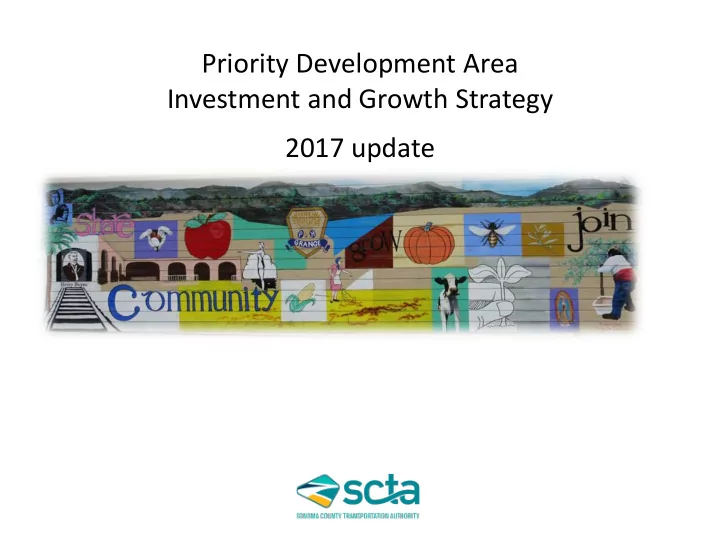

Priority Development Area Investment and Growth Strategy 2017 update
What is the PDA IGS? • A requirement by MTC/ABAG as part of the One Bay Area Grant (OBAG) program. • Opportunity to review status of PDAs • Update on Station Area and PDA Planning • Review of smart growth policies and equity issues
What is a PDA? Priority Development Areas (PDAs) are locally-identified, infill development opportunity areas within existing communities.
Enhancing our cities Santa Rosa’s four PDAs are located along corridors linked to the SMART stations. MTC/ABAG expect Santa Rosa PDAs to add 13,000 housing units and 4,700 jobs by 2040. Santa Rosa’s Railroad Square Windsor’s Town Green PDA, adjacent to the SMART Station, is a hub for economic and community activities; helping to make the downtown a more walkable, mixed-use environment . Windsor Town Green
Smart planning preserves small town character PDAs in the County’s smaller cities—Cloverdale, Cotati and Windsor near SMART stations, and the Rural Community Investment Area in the Springs —are anticipated to accommodate most new housing and jobs helping protect their character while supporting higher transit ridership and greater housing choices. Infrastructure improvements enhance safety and quality of life in the existing transportation corridors, making them more appealing for future residents. Before and after streetscape improvements in Cloverdale
Public outreach has been a critical component of all Station Area and PDA Plans
Status of the plans
Sonoma County communities have been actively planning growth around existing transit corridors and reducing sprawl for 20 years • Urban Growth Boundaries in every city since the early 1990’s • Voter supported Agricultural Preservation and Open Space District – ¼ cent sales tax since 1990 • Creation of the Regional Climate Protection Authority in 2009
The fine print Specifically, to qualify to be a PDA an area must meet the definition as described in the “Plan Bay Area Application and Guidelines: Priority Development Area Designation” Area — means the planning area being proposed for designation as a priority development area, • the recommended area size is 100 acres, which is approximately a ¼ mile radius. Existing Community — means that the area is within an existing urbanized area, lies within an • urban growth boundary or limit line if one is established, and has existing or planned infrastructure to support development that will provide or connect to a range of services and amenities that meet the daily needs of residents making non-motorized modes of transportation an option. Housing — means the area has plans for a significant increase in housing units to a minimum • density of the selected place type from the Station Area Planning Manual, including affordable units, which can also be a part of a mixed use development that provides other daily services, maximizes alternative modes of travel, and makes appropriate land use connections. Near Transit — means (1) the area around an existing rail station or ferry terminal (typically a half- • mile around the station), (2) the area served by a bus or bus rapid transit corridor with minimum headways of 20 minutes during peak weekday commute periods, or (3) the area defined as a planned transit station by MTC’s Resolution 3434.
Rural areas in dire need of infrastructure improvements Unincorporated Sonoma County has designated 6 Rural Community Investment Areas and one Employment Investment Area. These areas are not expected to ever have the densities found in more urban areas, but have existing centralized population centers and services. The Springs Rural Community Investment Area (near Sonoma) has a vibrant community and existing density and proximity to services. Current plans for the Springs could accommodate an additional 250 - 700 housing units by 2040. Bus stop in Sonoma Valley
Housing crisis in Sonoma county • Doesn’t look the same as more urban areas • Ripple effect of high prices in Bay Area • Scattered and suburban poverty, not concentrated in downtowns
• This document serves as documentation for focused growth in Sonoma County. • So far most of the PDAs have terrific plans. Funding for implementation is needed. • Thank you
Recommend
More recommend